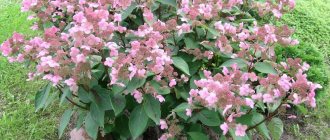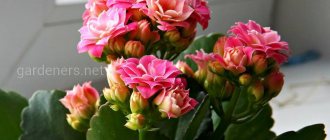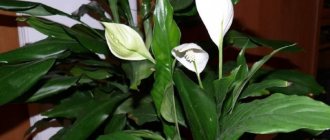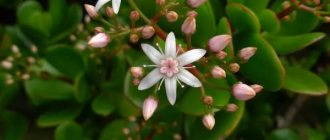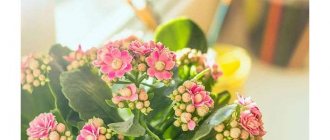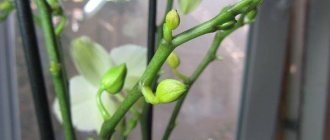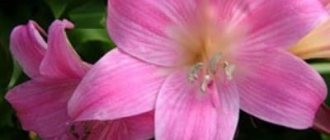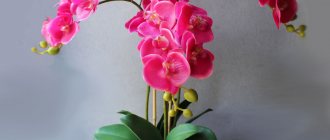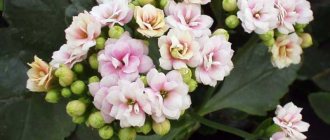Decorative flowering Kalanchoe is a very unpretentious indoor plant. Caring for it is not difficult. A bush purchased in a store pleases with abundant flowering for a long time.
However, it is not always possible for inexperienced gardeners to achieve re-blooming at home. Very often the leaves of the plant become smaller and the buds do not appear. Don’t rush to throw away your Kalanchoe: following basic rules of caring for it will help ensure the appearance of flowers.
Incorrect lighting and long daylight hours
Kalanchoe needs bright sunlight. In this case, the daylight hours for this plant should be no more than 8-9 hours. Therefore, in the middle zone it is almost impossible to achieve flowering in natural light.
In the summer, when there are many sunny days, daylight reaches 15-16 hours, but in winter, when it approaches normal, there is almost no sun.
If the Kalanchoe does not bloom and stretches out, you need to do the following:
- Keep the flower on a bright eastern windowsill so that it is exposed to the sun's rays in the morning;
- Limit daylight hours to 8-9 hours;
- In winter, when there is little sun, you can use artificial lighting lamps;
- If the plant does stretch out in winter, it is necessary to regularly carry out formative pruning of the bush, shortening its shoots to 10 cm.
Types of flower and photo
Naturally, it is impossible to describe all the varieties, since there are too many of them, but the most common ones can be identified and shown in the photo.
Blossfeld
A low shrub with egg-shaped, dark green leaves has been selected for home cultivation. The inflorescence is a lush panicle of different flowers : white, pink, yellow, red (in nature, only white flowers are found).
Beharskoe
Wedge-shaped leaves of olive color (with a small fluff), blooms with medium-sized yellow flowers. Its peduncle is very elongated (reaches 60 cm), the plant requires frequent pruning.
Fiery
The leaves are dark green, ovoid in shape, tapering towards the stem, this is a very decorative bush - the flowers are bright red-orange, double, flowering is quite long.
Terry
The leaves are oval green, the flowers are double, medium-sized, bright pink.
Rosalina mix
The leaves are oval-shaped, the plant is small, one might say miniature , but its flowering is very vigorous and long-lasting, the flowers are varied in color (red, pink, yellow, white, purple).
Too frequent and abundant feeding or lack thereof
A mandatory procedure for caring for Kalanchoe is feeding it with fertilizers.
But here it is important not to overfeed him. The plant reacts very poorly to excess nutrients and minerals in the soil. If it is fed too often, it may stop blooming or drop the buds it has formed.
Feed the flower from May to early October 1-2 times a month. In this case, you need to use fertilizers not for flowering plants, but for succulents . The concentration when diluting the fertilizer in water should be 2 times lower than indicated on the package. In the autumn-winter period, the plant is not fed.
If Kalanchoe grows in very poor, nutrient-deprived soil, it will bloom reluctantly even with the right lighting. Its leaves become smaller, Kalanchoe grows upward and does not bloom. Therefore, for annual and abundant flowering, you cannot completely abandon the application of fertilizers.
Why does Kalanchoe stretch?
The answer is very simple and universal for all plants. The plant will always behave this way when it lacks light . In other words, you chose a too shady place for it, so it stretches out.
What to do?
Move the flower to another more illuminated place. Optimally on an eastern or south-eastern window sill .
If your Kalanchoe looks like this photo, then know that you have chosen the wrong window for it.
Important! You need to keep (maintain) balance. If there is little light, then the temperature should be low. If the temperature is high, then the lighting should be good.
No rest period
For proper growth and flowering, the plant needs a period of rest. It is usually organized in September or October so that the flower has time to bloom by winter. The rest period lasts one month.
To organize the flower's rest, it is necessary to limit its watering and reduce the temperature to 12-15°C . In such conditions, it hardly grows or stretches without intense sunlight. Some experienced gardeners recommend keeping the plant in complete darkness at this time and not watering it at all. After the end of dormancy, the flower is gradually transferred to the normal watering regime.
Growing Kalanchoe all year round at room temperature and regular watering, it is almost impossible to achieve flowering.
In winter, it becomes very elongated without sunlight; only weak shoots grow on it, which never produce flowers. And after a month of keeping it cool with limited watering, the flower begins to intensively grow buds.
Features of Kalanchoe flowering at home
There are more than 200 varieties of culture in nature, and no more than 20 species live in houses. Tropical plants are accustomed to harsh environments to survive and do not require careful or complex care from their owners.
Kalanchoe does not bloom
Fleshy foliage has the ability to accumulate moisture, which allows the plant to go without water for a long time. But the formation of buds directly depends on the maintenance standards.
In addition to its decorative appearance, the culture is characterized by medicinal properties, which are widely used not only in folk but also in official medicine. Tinctures created from it:
- accelerate wound healing,
- suppress inflammatory processes,
- stop bleeding.
Industrially extracted juice can be purchased at any pharmacy.
Important! Because of its medicinal properties, the culture was called the “tree of life” or “doctor plant.”
How many times a year does it bloom, periods of activity and dormancy?
The formation of buds begins in winter; the exact time depends on the subspecies of Kalanchoe. With the arrival of spring days and warmth, they fall off, increasing their life expectancy is achieved by specialized techniques.
Some varieties of the crop are late-flowering - the first buds appear in early spring and fall off by the end of September or beginning of October. After the completion of the phase, the plant enters a dormant period: it is necessary to restore strength.
Important! Without observing the required rest time, the succulent will not form buds. To create complete dormancy, the wilted parts of the plant are removed and the pot is moved to a place with reduced daylight hours. Watering is logically reduced, and fertilizing is suspended until the next growing season.
Blooming succulent
Incorrect watering mode
Very often, the flowering of Kalanchoe is prevented by improper watering regime. How to water this plant correctly? We should not forget that this flower is a succulent. It accumulates moisture reserves in its fleshy leaves and is adapted to drought and low air humidity. Water it regularly, but very moderately.
In summer, Kalanchoe should be watered so that the ground is moist but not wet. All excess water flowing into the pan must be drained so that it does not humidify the surrounding air.
Between waterings, the soil should dry out to at least 3 cm in depth. In winter, watering is reduced by 2 times.
Water the plant very carefully so that water does not get on the leaves and shoots. The slightest stagnation of water in the soil can cause rotting of the root system, and moisture on the leaves can cause stem rot. These diseases are difficult to detect immediately and develop gradually. A diseased plant does not bloom, then loses its leaves and dies.
Kalanchoes do not bloom at home: how to solve the problem
Now let’s figure out how to eliminate one or another reason why the succulent does not bloom.
What kind of lighting does an indoor flower need to bloom?
Since this is a typical southerner, in nature Kalanchoe grows successfully under the scorching rays of the sun. True, its leaves turn slightly red from the sun, and if it does not have enough moisture, they will lose turgor.
Knowing these features, at home it is recommended to place it indoors so that the light is bright but diffused. Then the plant will show all its decorative qualities. It can be placed on any window sill, but in the summer, preference should be given to the western, southwestern and eastern ones, and in winter, transfer the flower to the southern window.
| On a note. If the weather is cloudy for a long time and it gets dark early, it would be a good idea to organize lighting. Do not place the pot in a dark corner or far from the window. In this case, the leaves begin to turn pale and lose their bright color, the lower leaves dry out and fall off, and the decorative appearance of the plant is lost. And you can’t expect flowering in a dark corner at all! |
Dependence of plant flowering on temperature and air humidity
Providing the necessary temperature conditions is an important part of care if the Kalanchoe does not bloom. For successful development, the plant requires moderate air temperatures from + 12 to + 28 degrees. In our conditions, when there is seasonality, the optimal temperature regime will be as follows:
- In summer - from + 20 to + 28 degrees. The succulent easily tolerates hotter weather, but if there is little watering, it can shed its leaves. Ideally, in the summer it is advisable to take the plant outside, to a balcony or terrace. Kalanchoe can remain there until autumn. When the weather starts to change, we bring it indoors.
- In winter - from + 10 to + 17 degrees. A short-term drop in temperature to + 7 degrees is possible. But if the temperature drop continues and the soil in the pot is wet, the plant may rot and die.
Kalanchoe does not have any special requirements for air humidity. The plant feels good at normal humidity and easily tolerates slight increases or decreases. In summer you can spray the plant daily, but in winter you need to be careful when spraying and bathing the flower in the shower. It is better not to carry them out, as excessive moisture and a cold window sill can cause rot in the roots.
Photo pixabay/Joshua_seajw92: Provide comfortable conditions for the flower.
Watering and feeding Kalanchoe for luxurious flowering
Watering is moderate, as the top layer of soil in the pot dries. In summer we increase watering to 2-4 times a week, in winter we reduce it slightly. But if the pot is located near a hot radiator, then water it, focusing on the condition of the soil in the pot. Excess moisture is very dangerous for a succulent, as is its long-term absence. If the earth is completely dry and petrified, then the leaves wither, lose color, and you can forget about flowering.
We water the houseplant only with settled water at room temperature. Do not water with cold water. Cold and dampness can cause rot in the roots. If the roots of a plant rot, it will not bloom.
Kalanchoe does not grow quickly, so it does not need increased nutrition. During the warm period, when the plant is vegetating, it is necessary to feed once a month. It is best to feed with liquid fertilizers at the root. The fertilizer must be diluted strictly according to the instructions, or better yet, in a slightly lower concentration than what is written by the manufacturer.
| Important! Excess fertilizer is harmful to succulents. |
Photo pixabay/Hans: Thanks to its fleshy leaves, the plant can go without water for a long time.
How to choose soil and replant a non-flowering plant
In nature, this succulent grows in different soils, including poor ones. Therefore, special mixtures for Kalanchoe are not needed. Purchased soil “for cacti and succulents” or “universal for flowers” is suitable. You need to add vermiculite or sand to the universal one to loosen it. The soil should be loose. A drainage layer in the pot is required.
Young plants need to be replanted annually in the spring - into a new, slightly larger pot. It is better to replant using the transshipment method, without disturbing the roots. Adult plants are transplanted into new soil every 3–4 years.
We achieve flower blooming with proper pruning
Pruning the crown is what needs to be done if the Kalanchoe has become elongated and does not bloom. If you ignore it, the shoots become even more elongated, look sloppy, there is scanty and unsightly flowering, or there is no flowering at all. In the absence of pruning, the leaves become noticeably smaller, flower buds are formed only on young shoots!
You need to trim according to the following pattern:
- Use sharp, disinfected instruments.
- It is advisable to powder the cut areas with crushed charcoal. But I never treated it with anything: I simply did not spray the plant for several days so that the wounds healed.
- When the dormant period comes to an end, it is necessary to cut off all the shoots to about half, cut out all crooked, diseased, old shoots and shoots growing inside the crown. Don't be afraid and don't feel sorry for the plant! The bolder the pruning, the more magnificent the bush will turn out.
- After the plant has finished blooming, we cut off all the flower stalks to make the plant look neater. You can pinch the tops of the shoots at the same moment.
Lack of flowering due to dormancy
A period of rest is necessary for this plant. At this time, it lays flower buds. The dormant period is characterized by a decrease in temperature, reduced watering, lack of fertilizing, and a day length of 8 hours.
This period can last from 2 to 5 weeks, depending on the type and variety of the plant. In an ordinary apartment it can be difficult to create such conditions, so there is no flowering.
Now you know what to do if the Kalanchoe is stretched and does not bloom. Follow our recommendations and enjoy luxurious flowers!
Photo pixabay/Irina_kukuts: Perhaps the plant is dormant. _____________________________________________________________________ Read our other articles about indoor flowers: Lunar calendar for planting and replanting flowers for the year 7 reasons why an orchid does not bloom, and how to get an exotic beauty to bloom How to grow an exotic scindapsus at home: care, replanting, propagation How to grow a Decembrist at home: tips on planting, caring for and propagating succulents _________________________________________________________________________ How do you get Kalanchoe to bloom? Share your experiences and tips with other gardeners in the comments.
Other possible causes and solutions
In addition to lighting, feeding and watering, the following factors also influence the ability of a plant to bloom:
- Soil composition;
- Content temperature;
- Air humidity;
- Diseases and pests.
The soil for planting Kalanchoe should not be too nutritious or poor. Excess, as well as lack of nutrients, has a bad effect on the plant’s ability to grow buds.
The best soil for succulents here is with the addition of coarse sand. There is no excess humus in such soil, but it is quite saturated with minerals.
And sand prevents soil caking and promotes moisture penetration to the roots.
Despite the fact that Kalanchoe is a resident of warm countries, it does not tolerate too high temperatures. The optimal range for it is 20-25°C in summer and 15-18°C in winter. During the rest period, the temperature can be reduced to 12-15, but not lower than 10°C.
Kalanchoe requires low air humidity . When it is over-moistened, fungal diseases develop, leading to the death of the plant. To achieve flowering, in addition to proper watering, you also need to keep the plant dry. Only under such conditions will it be possible to cause annual and sometimes repeated flowering.
Only healthy Kalanchoe can bloom. With any disease or pest damage, growing buds becomes impossible.
The plant is susceptible to root and stem rot. These fungal infections develop only with improper watering and high air humidity. Aphids and scale insects also settle on the flower. To maintain the health of the plant, it must be treated with insecticides to kill harmful insects.
Now you know why Kalanchoe does not bloom and grow upward, and what to do to correct care errors.
Possible problems
Of course, everyone wants to get to the truth and find out the reason - what is happening to the flower, why such a seemingly unpretentious flower, which should bloom “forever,” completely stops doing so. Let's figure it out.
To begin with, it is worth noting that when a flowering Kalanchoe is prepared for sale, they are specially engaged in forcing , that is, they artificially induce the plant to bloom. Moreover, everything is calculated exactly - the plants are planted in a certain soil with the addition of nutrients and fertilizers, thanks to which the flower blooms beautifully for about two months. But after this his strength is running out, after all, he gave it his all and now we need to try to get the Kalanchoe to bloom again.
There are two options for the development of a plant after a “store” flowering - it does not bloom again, but only increases the green mass, that is, leaves grow or the plant stretches strongly upward. We talked about how to achieve abundant flowering of Kalanchoe after purchasing it in our material.
In addition to problems with Kalanchoe flowering, there are other troubles that can even lead to the death of the flower. To avoid unpleasant surprises, we recommend reading our articles:
- Why do Kalanchoe leaves turn yellow and what to do about this and other problems?
- Pests and diseases of Kalanchoe, methods of treatment.
Only leaves grow
Sometimes this situation occurs - a good lush bush produces only foliage, but the buds are in no hurry to form, in this case the most likely reason is that the plant is overfed with fertilizers. Naturally, Kalanchoe needs feeding, but only a little, everything is strictly dosed. The reason may also be due to incorrect temperature conditions.
Pulls up
The shoots of the flowering Kalanchoe stretch upward, and there they become even thinner; they do not lay buds - first of all, this is due to a lack of light.
Sometimes the bush begins to lose the lower leaves and it turns out to be an ugly bare trunk and only the very top has a few leaves - this situation can arise due to too much watering - again the plant is forced to survive as best it can, Kalanchoe does not need a lot of water, because it is a succulent, and many They try to water it from the heart.
This can also happen due to the fact that the plant is not cut in any way, its appearance is not formed, everything is left to chance.
How to provoke flowering
How to make Kalanchoe bloom at home? In order for Kalanchoe to bloom intensively every year and have a decorative appearance, it must be properly cared for.
If the flower is planted in soil of optimal composition, it is not overfed and the necessary watering regime is observed, then achieving flowering will not be difficult. Usually Kalanchoe blooms annually in winter in January-February, but in summer a second wave of flowering can be caused.
For the formation of buds in winter, additional lighting with electric lamps is necessary. The length of winter daylight hours in the middle zone approaches that necessary for the plant to flower.
But the lack of sunlight most often leads to stretching of shoots. Only electric backlight for 8-9 hours daily will lead to the desired result.
After winter flowering, the flower stalks must be cut off, and the plant must be given a dormant period of 1 month . Next, it is exposed to sunlight and artificially regulated daylight hours, putting the flower in the closet 2-3 hours after noon.
You don’t have to move the plant, but simply cover it with a light-proof cap. In this mode, Kalanchoe can bloom a second time in July or August. After summer flowering, you also need to provide it with a period of rest.
You can read more about the conditions for flowering Kalanchoe here.
How to make Kalanchoe bloom in good conditions
Kalanchoe: home care and main family species
Full compliance with the rules of plant care does not guarantee the appearance of inflorescences. Many gardeners are wondering what needs to be done to make Kalanchoe bloom. There are several nuances that help to force the bush not only to bloom, but to increase this period in time. The procedures are carried out after the end of the budding season.
The gardener will have to create an environment similar to nature - in its natural habitat, the crop experiences a tropical winter with decreasing daylight hours, rare rains and lower temperatures. After the gardener creates an analogy, the plant can bloom.
Pruning to promote flowering
What do I need to do
The plant should be forced to produce inflorescences by step-by-step application of the following procedures:
- Artificially put the specimen into a state of hibernation for 2-3 months. To stop growth and development, the stems are cut almost to ground level, the container is covered with thick material and put away in a dark room. The temperature in the room must be maintained at +15 degrees. Irrigation of the substrate is carried out twice a month; fertilizers are not applied during the entire period.
- From the first summer months until November, it needs to form a strong crown. The box is returned to its original place, watering is carried out after the soil has dried, every 10 days. The temperature is maintained at +16..+25 degrees. To increase the density of the green part, excess leaves are removed, trying to maintain uniform proportions.
- Stimulating bud growth requires creating an eight-hour daylight hours, moderate irrigation of the substrate and a temperature of +18 degrees. The first buds will form in 3-5 days.
A secondary method used to stimulate the kidneys involves the use of stress therapy. The succulent is wrapped in thick, light-proof fabric and sent to a dark room for one month. You need to stop watering or feeding it for the entire period.
For an experienced gardener, finding the root cause of the lack of buds on a succulent is not difficult. With careful observation, external changes can be identified that indicate a developing problem. While observing the rules of crop care, do not forget that excessive soil moisture often leads to the development of fungal pathologies and attacks by parasitic insects. Only exact fulfillment of the requirements will help to grow a healthy and periodically flowering plant, with good immunity and resistance to diseases and pests.
